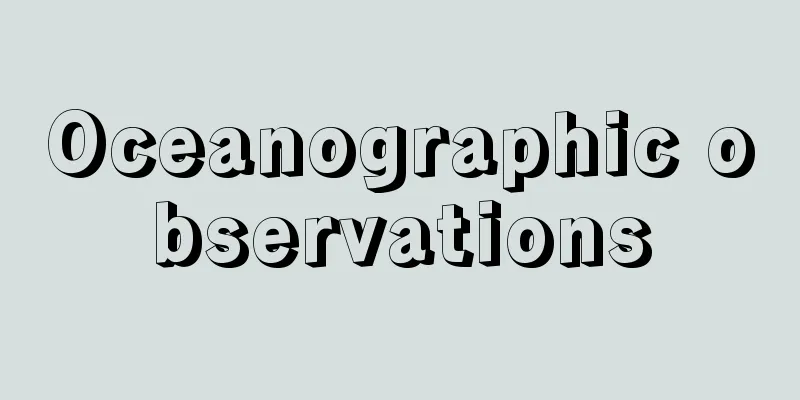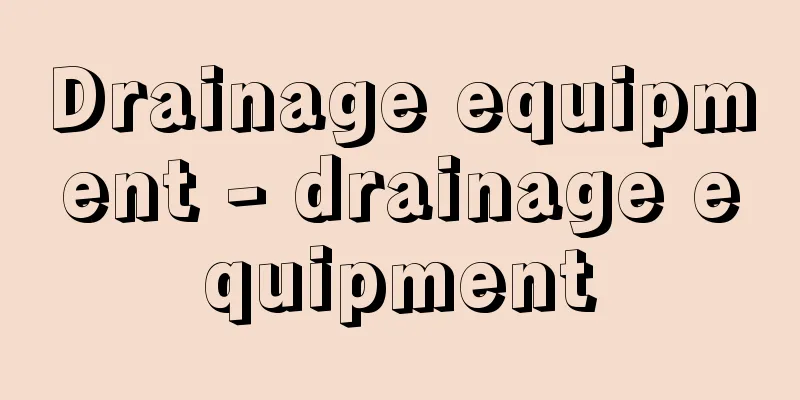Oceanographic observations

|
A general term for observations conducted to investigate ocean phenomena and conditions. Ocean observations generally include measurements and collection of seawater quality such as temperature, salinity, density, water color, transparency, amount of dissolved oxygen, hydrogen ion concentration (pH), and nutrients; ocean water movements such as ocean currents, waves, and tides; marine life such as juvenile fish, benthic organisms (benthos), and plankton; and even seafloor topography, geomagnetism, gravity, and geology. Ocean observations can also include meteorological observations at sea. [Kouichi Nagasaka and Koichi Ishikawa] Purpose of ocean observationWith the development of natural sciences, oceanographic observations began as an academic pursuit, but as human socio-economic activities spread to the oceans and plans were made to utilize and develop them, their objectives have expanded. Meanwhile, as the importance of global environmental issues has increased, monitoring of the global environment and conservation of the oceans have also become important objectives of oceanographic observations. The main objectives of oceanographic observations are listed below. (1) To understand the nature of the ocean and to academically explain the various phenomena occurring there. This has been the basic objective of oceanographic observation since its inception. (2) To promote the sustainable use of marine living resources. (3) To contribute to the safe and efficient operation of ships. (4) To monitor and prevent pollution of the marine environment. (5) To promote the utilization and development of marine mineral and energy resources. (6) To promote the use of renewable marine energy and resources, such as thermal energy generation. (7) To prevent coastal disasters such as high tides. (8) To improve the accuracy of weather forecasts. (9) To obtain data for ocean condition forecasts. (10) To monitor changes in the global environment, such as global warming. [Kouichi Nagasaka and Koichi Ishikawa] History of ocean observationThe history of human ocean exploration is very long, dating back to ancient times, but until the invention of scientific oceanographic instruments in the mid-18th century, exploration was mainly focused on geographical exploration. Modern oceanographic observations began in the second half of the 19th century, and in particular, the first ever circumnavigation of the globe by the British ship Challenger, conducted from 1872 to 1876, brought mankind a great deal of knowledge that became the foundation of modern oceanography. This voyage, under the command of C. W. Thomson, covered 68,892 nautical miles (approximately 127,600 km) in the Atlantic, Pacific, and Indian Oceans, and included 492 deep-sea soundings, 263 water temperature measurements, 137 mud samples, and 151 trawls for collecting plankton. The results of the observations were compiled into a total of 50 volumes over the course of the next 20 years. This observation triggered a trend of large-scale oceanographic observations in various countries, targeting the open ocean. Until the mid-1950s, many such observations were conducted by a single research vessel covering a wide area, and were rather exploratory in nature. Among these, the Fram observation in 1893 provided basic knowledge of ocean physics, such as the relationship between wind and ocean currents. The German Meteor's oceanographic observations from 1925 to 1927 crossed the Atlantic 13 times, during which 310 water samples were collected and temperature was measured, and a full-scale bathymetry observation using an echo sounder provided an unprecedentedly accurate understanding of the ocean floor topography. This observation was also groundbreaking in terms of the thoroughness of its planning, the accuracy of the observations, and the appropriateness of the processing of the observation data. After the Second World War, new technologies, including electronics, were introduced into oceanographic observations, making it possible to conduct observations quickly and efficiently, and unlike the previous exploratory and routine observations, observations began to be planned with clearly defined objectives. Operation Cabot, an observation mission carried out in the 1950s using six research vessels and aircraft to elucidate the short-term variability of the Gulf Stream in the Atlantic Ocean, is famous as a new style of oceanographic observation. Since then, many experimental observations of this type have been carried out, mainly by the United States and the Soviet Union (Russia). Major international joint observations carried out since 1955 include the NORPAC (North Pacific Joint Observatory, summer 1955, United States, Canada, Japan), the EQUAPAC (Equatorial Pacific Observatory, 1956, United States, France, Japan) which targeted the equatorial Pacific region, the global IGY (International Geophysical Year observation, 1957), the CSK (Kuroshio and Adjacent Seas Joint Survey, from the mid-1960s to the mid-1970s, with the participation of many countries including Japan) which targeted the Western Pacific region, and the IGY (International Geophysical Year, 1957) which was carried out in the Kuroshio Current basin. These include WESTPAC (Western Pacific Ocean Cooperative Exploration), which began in 1979, with the participation of 20 countries including Japan, the United States, the Soviet Union, China and Australia; TOGA (Tropical Ocean and Global Atmosphere Research, 1985-1994), which aimed to elucidate the interactions between the tropical ocean and the atmosphere, and WOCE (World Ocean Circulation Experiment, 1990-2002), which aimed to develop ocean models to predict climate change and collect data necessary to verify the models. Furthermore, from the 1970s onwards, remote sensing technology using artificial satellites began to play an important role in ocean observation, and it can be said that it entered the practical stage in the 1990s. Since 2000, the Argo Project has been underway through international cooperation to deploy approximately 3,000 mid-depth floats (cylindrical observation devices that rise and sink automatically to observe water temperature and salinity from the surface to a depth of approximately 2,000 meters; also known as Argo floats) in the world's oceans, and to build a system to monitor and understand the conditions of the world's oceans in real time. In Japan, systematic oceanographic observations of offshore waters began around the 1930s by the Fisheries Experimental Station of the Ministry of Agriculture and Forestry (now the National Research and Development Agency, Fisheries Research and Education Agency), the Marine Meteorological Observatory (now the Kobe Regional Meteorological Observatory of the Japan Meteorological Agency), and the Navy Hydrographic Department (now the Marine Information Department of the Japan Coast Guard). After a period of inactivity during World War II, the Japan Meteorological Agency, the Japan Coast Guard, and the Fisheries Agency have been conducting regular oceanographic observations of the waters off Japan and the Western Pacific Ocean since around 1950 to achieve their respective administrative objectives. Additionally, universities such as the Atmosphere and Ocean Research Institute of the University of Tokyo and institutions such as the Japan Agency for Marine-Earth Science and Technology are actively conducting oceanographic observations for the purpose of scientific research into the ocean. [Kouichi Nagasaka and Koichi Ishikawa] Methods and types of ocean observationsThe subjects are extremely diverse, and a variety of methods are used, from classical to more recently developed. [Kouichi Nagasaka and Koichi Ishikawa] Observation by research vesselIt is the most basic means of ocean observation, and much of what we know about the oceans to date has been achieved through research vessels. [Kouichi Nagasaka and Koichi Ishikawa] Water temperature and salinity observationObservation of water temperature and salinity by observation vessels is generally carried out using a CTD (Conductivity-Temperature-Depth profiler). A CTD uses sensors to continuously measure water temperature, pressure, and electrical conductivity, and the underwater section is usually suspended in the sea by a wire cable, and data is acquired on board the vessel in real time. Observation data signals and the power required by the underwater section are transmitted through the wire cable. Salinity values are calculated from water temperature, pressure, and electrical conductivity. Observations using a CTD make it possible to obtain high-resolution water temperature and salinity data that is vertically homogenous. To quickly obtain the water temperature distribution in the surface layer for a few hundred meters from the surface, an XBT (Expendable Bathythermograph) is used. In an XBT, a weight with a thermistor (semiconductor device) embedded at the tip is attached to a thin enameled wire and dropped from a ship to measure. The enameled wire is unwound without tension, and the weight falls freely. The resistance of the thermistor is transmitted to the ship through the enameled wire, and the water temperature is calculated from the temperature change. The depth is calculated from the elapsed time after the weight hits the water. Since the water temperature distribution can be observed down to a depth of about 500 meters in just about one minute even from a ship traveling at 15 knots or more, XBTs are used not only on observation ships but also on volunteer observation ships such as merchant ships for observation on regular routes. In the late 1990s, the XCTD (Expendable Conductivity-Temperature-Depth profiler), which had an electrical conductivity sensor attached to the sinker, came into practical use, making it easy to measure both water temperature and salinity. [Kouichi Nagasaka and Koichi Ishikawa] Observation of seawater chemical composition, plankton, etc.Seawater samples are collected in an appropriate manner to measure the concentration of chemicals present in seawater. In observations using a CTD, a number of water samplers (usually 12, 24 or 36) are attached around the underwater part of the CTD using a mounting device (multi-bottle sampler), and are suspended in the sea together with the CTD to collect seawater samples. By sending an electric command to close the lids of the water samplers through a wire cable from the ship, water can be sampled at any depth while monitoring the water temperature and salinity on board. To measure trace elements in the seawater, a large volume water sampler that can collect large amounts of seawater (100 to 300 liters) at a time is attached to the wire to collect seawater samples. Most of the samples are chemically analyzed on board the observation ship, but some are stored for analysis on land and for plankton surveys. To observe plankton, in addition to taking water samples using a water sampler, a fine-mesh cone-shaped net (plankton net), about 50 centimeters in diameter and 2 meters long, is attached to the end of a wire and pulled through the ocean to collect plankton. [Kouichi Nagasaka and Koichi Ishikawa] Observation of ocean currentsMost observation vessels are equipped with surface current meters. Surface current meters are devices that continuously observe ocean currents up to several hundred meters above the sea surface while sailing, using an ADCP (Acoustic Doppler Current Profiler) attached to the bottom of the vessel, which was developed mainly in the United States and put to practical use in the late 1970s. The measurement principle is that ultrasonic pulses are emitted at a fixed time interval from a transducer attached to the bottom of the vessel, which are reflected by floating objects such as plankton and non-living particles in the sea and discontinuities in seawater density, and return to the transducer at the bottom of the vessel. The difference in frequency between the emitted and returned ultrasonic waves due to the Doppler effect (Doppler shift) is used to calculate the current speed of the reflected layer relative to the vessel. The current speed of the layer can be calculated by subtracting the speed of the vessel, which is calculated from the navigation equipment, etc. One method for observing mid-deep ocean currents is to moor an internal recording current meter. The mooring system has an anchor weighing nearly one ton at the bottom and an acoustic release device at the top, with ropes connecting the current meter and numerous glass buoys to the top, making it possible to observe ocean currents continuously for one to two years. At the end of observations, an ultrasonic signal is sent from the observation vessel to the acoustic release device, which releases the anchor, allowing the mooring system to float up and the current meter to be retrieved. [Kouichi Nagasaka and Koichi Ishikawa] Observation of transparency and water colorTransparency is an index of the average turbidity of the ocean surface. In broad daylight, a white, flat disk with a diameter of 30 centimeters called a transparency board is lowered horizontally into the seawater and the limiting depth at which it is no longer visible when viewed from above is observed. Water color is observed in broad daylight from a ship, where the color of the seawater in the shade is measured. Observations are made by comparing the color with the standard Forell-Uhle water color solution. [Kouichi Nagasaka and Koichi Ishikawa] Buoy system observationsBuoy systems can be broadly classified into moored buoys, drifting buoys, and mid-water floats. [Kouichi Nagasaka and Koichi Ishikawa] Mooring buoyRelatively large buoys are moored at sea to observe marine weather, surface water temperature, salinity, and ocean currents, and transmit the data to land via satellite. A representative example is the TAO (Tropical Atmosphere Ocean)/TRITON (Triangle Trans-Ocean buoy Network) buoy, of which about 70 are moored in the equatorial Pacific Ocean to monitor the El Niño phenomenon. [Kouichi Nagasaka and Koichi Ishikawa] Drifting buoyA small buoy (less than 1 meter in diameter) with a resistor (drogue) attached below the surface of the ocean so that it follows the ocean currents near the surface, drifts on the ocean surface and transmits its position to land via satellite to observe ocean currents. Usually, it is equipped with a water temperature sensor and observes sea surface temperature. Types that can observe marine meteorological elements (waves, air pressure) and salinity are also in practical use. [Kouichi Nagasaka and Koichi Ishikawa] Mid-level floatIt is a cylindrical observation device about one meter long that floats and sinks automatically, drifting at a preset depth, then rising to the surface, transmitting its position to land via satellite, then sinking again and drifting, repeating this process to observe mid-layer currents. In the late 1990s, mid-layer floats were equipped with water temperature and salinity sensors that measured water temperature and salinity as the floats rose to the surface, and transmitted the data via satellite when they rose to the surface, making it possible to use mid-layer floats to observe water temperature and salinity in real time from the surface to about 2,000 meters. [Kouichi Nagasaka and Koichi Ishikawa] Satellite observationSince the 1970s, it has been rapidly put into practical use as a new method for observing sea surface temperature, ocean currents, waves, etc. over a wide area and in a short period of time. [Kouichi Nagasaka and Koichi Ishikawa] Observation by acoustic wavesConventionally, ocean temperature and salinity have been measured by lowering measuring instruments directly into the ocean. However, since the late 1970s, efforts have been made to put into practical use ocean sonic tomography observations, which utilize the fact that the propagation characteristics of sound waves in the ocean are affected by the temperature and salinity distribution of the ocean. This is a method in which sound transmitters and receivers are placed in the ocean at distances of hundreds to thousands of kilometers, and average oceanographic characteristics during that time are observed using data such as the sound propagation time. If three to five transmitters and receivers are placed in an area of 1,000 square kilometers at a depth of 1,000 to 1,500 meters, where the vertical distribution of sound speed is at its minimum, it is expected that the water temperature distribution in a very wide area of the ocean can be measured with an accuracy of about ±0.1°C, dividing the area between 100 square kilometers horizontally and 500 to 4,000 meters vertically into three to five layers. In addition, observations are being conducted to detect changes in water temperature due to global warming by utilizing the long-distance propagation of sound waves. [Kouichi Nagasaka and Koichi Ishikawa] "Marine Science - Outlook for the Marine Environment" by P.K. Weil, translated by Sugiura Yoshio (1972, Kyoritsu Shuppan)" ▽ "Methods for Processing Marine Observation Data" by Yanagi Tetsuo (1993, Koseisha Kouseikaku)" ▽ "The Sea of Researchers" edited by Teramoto Toshihiko (1994, Seizando Bookstore)" ▽ "Wave Analysis and Forecast" by Isozaki Ichiro and Suzuki Yasushi (1999, Tokai University Press)" ▽ "Marine Observation Guidelines" edited by the Japan Meteorological Agency (1999, Meteorological Operations Support Center)" ▽ "The Story of Marine Observation - Its Technology and Evolution" by Nakai Shunsuke (1999, Seizando Bookstore)" ▽ "Coastal Marine Observation Using Land-Based Radar" edited by the Coastal Engineering Committee and Research Status Review Subcommittee of the Japan Society of Civil Engineers (2001, Japan Society of Civil Engineers, Maruzen Sales)" ▽ "Introduction to Ocean Observation" by Yanagi Tetsuo (2002, Koseisha Kouseikaku)" ▽ "The Observation Ship that Battled Typhoons" by Nobumura Yo (2002, Seizando Shoten)" ▽ "Lectures on Ocean Meteorology" by Fukuchi Akira, 9th edition (2003, Seizando Shoten)" ▽ "An Introduction to Ocean Physical Science" by Sekine Yoshihiko, 4th edition (2003, Seizando Shoten)" ▽ "Learning about the El Niño Phenomenon" by Saeki Michitaka, revised and expanded edition (2003, Seizando Shoten)" ▽ "The Sea" by Uda Michitaka (Iwanami Shinsho)" ▽ "The Challenger Expedition - The Dawn of Modern Oceanography" by Nishimura Saburo (Chuko Shinsho) [References] | | | | | | | | | | | | | | | | currents| | | | | | | | | | | | | | | | | | | | |Source: Shogakukan Encyclopedia Nipponica About Encyclopedia Nipponica Information | Legend |
|
海洋の現象や状態を調べるために行われる観測の総称。一般に海水の温度・塩分・密度・水色(すいしょく)・透明度・溶存酸素量・水素イオン濃度(pH)・栄養塩類などの水質、海流・波浪・潮汐(ちょうせき)などの海水の運動、稚魚・底生生物(ベントス)・プランクトンなどの海洋生物、さらには海底地形・地磁気・重力・地質などに関する測定や採集などを海洋観測とよんでいる。このほか、海上での気象観測も含めて海洋観測とよぶこともある。 [長坂昂一・石川孝一] 海洋観測の目的自然科学の発達とともに、学問的な要求から始まった海洋観測は、人類の社会経済活動が海洋にも広がり、海洋の利用開発が企てられるにつれて、その目的は拡張されてきた。一方、地球環境問題の重要性が増大するにつれ、地球環境の監視、海洋保全も海洋観測の目的として重要になってきた。以下におもな海洋観測の目的を示す。 (1)海洋の本質を理解し、そこに生起する諸現象を学究的に解明するため。海洋観測発足時からの基本的な目的である。 (2)海洋生物資源の持続的な利用を図るため。 (3)船舶の安全と効率的な運航に資するため。 (4)海洋環境の汚染状況の監視と汚染の防止のため。 (5)海洋鉱物・エネルギー資源の利用開発の促進のため。 (6)温度差発電等の再生可能な海洋エネルギー・資源の利用推進のため。 (7)高潮等の沿岸災害の防止のため。 (8)気象予報の精度向上のため。 (9)海況予報のためのデータ取得のため。 (10)地球温暖化等の地球環境の変動の監視のため。 [長坂昂一・石川孝一] 海洋観測の歴史人類の海洋探究の歴史は非常に古く、太古の昔にまでさかのぼることができるが、科学的な海洋観測測器が発明される18世紀中ごろまでは、その対象はもっぱら地理的探検が中心であった。近代的な海洋観測が行われ始めたのは19世紀後半に入ってからで、なかでも、1872年から1876年にかけて実施されたイギリスのチャレンジャー号による史上初めての世界を一周する海洋観測は、近代海洋学の基礎となる数多くの知見を人類にもたらした。この航海はC・W・トムソンの指揮のもとに大西洋・太平洋・インド洋の6万8892海里(約12万7600キロメートル)にわたり、途中、深海測深492点、測温採水263点、採泥137点、プランクトン採集のためのトロール151点などの観測が行われた。観測の成果は、その後二十数年の年月を費やして、全部で50巻の報告に取りまとめられた。 この観測を契機に、各国で外洋域を対象とした大規模な海洋観測が盛んになり、その後、1950年代中ごろまで、このような1隻の観測船による広い海域を対象とした、どちらかといえば探検的色彩の強い海洋観測が数多く行われた。このうち、1893年のフラム号による海洋観測は、風と海流の関係など海洋物理に関する基本的な知見をもたらした。また、1925年から1927年にかけてのドイツのメテオール号による海洋観測は、13回にわたり大西洋を横断し、この間310点の採水測温観測を行うとともに、音響測深機による本格的な測深観測により、これまでにない正確な海底地形の把握が行われた。またこの観測は、その計画の周到さ、観測の正確さ、観測資料処理の適切さなどの点で、これまでの観測をしのぐ画期的なものであった。第二次世界大戦後、エレクトロニクスをはじめとする新しい技術が海洋観測に取り入れられ、迅速で効率的な観測が可能になり、それまでの探検的で定型的な観測と異なり、目的をはっきり絞った観測が計画されるようになった。 1950年代、大西洋の湾流の短期変動特性の解明を目ざした6隻の観測船と航空機による観測「オペレーション・キャボット」Operation Cabotは、新しい形式の海洋観測として有名である。その後、アメリカ、ソ連(ロシア)を中心にこの形の実験観測が数多く実施されている。1955年以降に行われた国際共同観測のおもなものに、ノルパック観測(NORPAC、北太平洋共同観測。1955年夏。アメリカ、カナダ、日本)、太平洋の赤道海域を対象としたエクワパック観測(EQUAPAC、赤道太平洋観測。1956年。アメリカ、フランス、日本)、世界的規模のIGY観測(国際地球観測年の観測。1957年)、黒潮流域を対象としたCSK観測(黒潮および隣接海域共同調査。1960年代中期から1970年代中期、日本をはじめ多くの国が参加)、西太平洋海域を対象として1979年に始まったウェストパック(WESTPAC、西太平洋共同調査。日本、アメリカ、ソ連、中国、オーストラリアをはじめ20か国が参加)、熱帯海洋と大気の相互作用の解明のためのトガ(TOGA、熱帯海洋・全球大気変動研究計画。1985年~1994年。これを契機に太平洋熱帯域に気象海洋観測ブイ網が展開された)、気候変動の予測のための海洋モデルの開発と、モデルの検証に必要なデータ収集を目的としたウォース(WOCE、世界海洋循環実験計画。1990年~2002年)などがある。また1970年代以降は人工衛星によるリモート・センシング(遠隔探査)技術が海洋観測に重要な役割を果たし始め、1990年代には実用段階に入ったといえる。2000年からは、国際協力により全世界の海洋に約3000個の中層フロート(自動的に浮き沈みして、海面から水深約2000メートルまでの水温・塩分を観測する筒状の観測機器。アルゴフロートともよばれる)を展開し、全世界の海洋の状況をリアルタイムで監視・把握するシステムを構築するアルゴ計画Argo Projectが進められている。 日本では、ほぼ1930年代から、沖合いの海域を対象とした系統的な海洋観測が、農林省水産試験場(現在の国立研究開発法人水産研究・教育機構)、海洋気象台(現在の気象庁神戸地方気象台)、海軍水路部(現在の海上保安庁海洋情報部)によって始められた。その後第二次世界大戦中の空白期を経て、1950年(昭和25)ごろから気象庁、海上保安庁、水産庁などにより、それぞれの行政目的を達成するために、日本近海や西太平洋を対象とした海洋観測が定期的に実施されている。また、東京大学大気海洋研究所などの大学、国立研究開発法人海洋研究開発機構などの機関でも海洋の学理的研究のための海洋観測が盛んに行われている。 [長坂昂一・石川孝一] 海洋観測の方法と種類対象が非常に多方面にわたり、その方法も古典的なものから近年開発されたものまで、種々の手段が用いられている。 [長坂昂一・石川孝一] 観測船による観測海洋観測のもっとも基本的な手段であり、これまでの海洋に関する知見の多くが観測船の成果である。 [長坂昂一・石川孝一] 水温・塩分の観測観測船による水温、塩分の観測は、CTD(電気伝導度水温水深計Conductivity-Temperature-Depth profiler)を使って行うのが一般的である。CTDは、センサーによって水温、圧力、電気伝導度を連続して測定するもので、通常、ワイヤケーブルによって水中部を海中につり下げ、リアルタイムに船上でデータ取得を行う。観測データの信号および水中部が必要とする電力は、ワイヤケーブルを通じてやりとりされる。塩分値は、水温、圧力、電気伝導度から計算して求める。CTDによる観測は、鉛直方向に均質な高分解能の水温、塩分データを得ることを可能にした。 海面から数百メートルの間の表層の水温分布を迅速に取得するためには、XBT(投下型自記水温水深計Expendable Bathythermograph)による観測がある。XBTは、先端にサーミスター(半導体デバイス)を埋め込んだ錘(おもり)を細いエナメル線に取り付けて、船から投下させて測定するものである。エナメル線は張力がかからないように繰り出され、錘は自由落下する。サーミスターの抵抗値がエナメル線を通じて船上に送られ、その温度変化から水温を計算する。深度は錘が着水してからの経過時間により求められる。15ノット以上で航走中の船舶からでも深さ500メートル程度までの水温分布が、わずか1分ぐらいの間に観測できることから、観測船だけではなく商船などの篤志観測船に搭載して定期航路上での観測にも用いられている。1990年代後半には、錘に電気伝導度センサーも取り付けたXCTD(投下型自記電気伝導度水温水深計Expendable Conductivity-Temperature-Depth profiler)が実用化され、手軽に水温、塩分の両方が測定できるようになった。 [長坂昂一・石川孝一] 海水の化学成分、プランクトンなどの観測海水中に存在する化学物質の濃度を測定するために、海水試料を適切な方法で採取する。CTDを使った観測の場合には、多数(通常12、24あるいは36本)の採水器を、CTDの水中部の回りに、取付け装置(マルチボトルサンプラー)により配置し、CTDとともに海中につり下げて海水試料を採取する。船上からワイヤケーブルを通じて採水器の蓋(ふた)をしめる電気指令を送る方式により、船上で水温と塩分を監視しながら任意の深度で採水することができる。海中の微量元素などの測定には、100~300リットルという大量の海水を一度に採水する大量採水器を、ワイヤに取り付けて海水試料を採取する。試水の多くは観測船上で化学分析されるが、一部は陸上での分析やプランクトン調査のために保管される。 プランクトンの観測のために、採水器による試水の採取のほかに、直径50センチメートル、長さ2メートル程度の円錐(えんすい)形をした目の細かい網(プランクトンネット)をワイヤの先端に取り付けて海中を引き、その採取を行う。 [長坂昂一・石川孝一] 海流の観測観測船の多くには、表層海流計が装備されている。表層海流計は、主としてアメリカで研究が進められ、1970年代末に実用化されたADCP(超音波式ドップラー多層流速計Acoustic Doppler Current Profiler)を船底に取り付けて、航走しながら連続的に海面から数百メートルまでの海流観測を行う装置である。測定原理は、船底部に取り付けた送受波器から、一定時間幅で発射された超音波パルスが、海中のプランクトン・非生物粒子等の浮遊物や海水密度の不連続により反射されて、船底部の送受波器に戻ってくる。ドップラー効果による発射された超音波と戻ってきた超音波の振動数の差(ドップラーシフト)から、反射した層の船に対する流速を求める。航法装置等から求めた船の速度を差し引くことにより、その層の流速が求められる。 中深層の海流の観測に、内蔵記録式の流速計を係留する方法がある。係留系は、最下部に1トン近くのアンカーとその上部に音響式切離装置を置き、そこからロープにより流速計と多数のガラスブイを連結しながら上部に伸びた構造をしており、1~2年間の連続した海流観測が可能である。観測終了時には、観測船から音響式切離装置に超音波信号を送りアンカーを切り離すことにより、係留系を浮上させて、流速計を回収する。 [長坂昂一・石川孝一] 透明度・水色の観測透明度は、海洋表層の平均的な海水の濁りの指標であり、白昼に、透明度板という直径30センチメートルの白色の平らな円盤を水平に海水中に降ろし、上から見てこれがちょうど見えなくなる限界の深さを観測する。水色の観測は、白昼に船上から日陰の部分の海水の色を求める。観測は、フォーレル・ウーレ水色標準液と比較する方法で行う。 [長坂昂一・石川孝一] ブイ・システムによる観測ブイ・システムは、係留ブイ、漂流ブイ、中層フロートに大きく分類できる。 [長坂昂一・石川孝一] 係留ブイ比較的大型のブイを海上に係留し、海上の気象や表層の水温、塩分、海流を観測し、人工衛星を経由してそのデータを陸上に伝送するものである。代表的なものに、エルニーニョ現象の監視のために、太平洋の赤道域に約70台係留されているタオ(TAO:Tropical Atmosphere Ocean)/トライトン(TRITON:Triangle Trans-Ocean buoy Network)ブイがある。 [長坂昂一・石川孝一] 漂流ブイ海面付近の海流に追随するように海面下に抵抗体(ドローグ)が取り付けられた小型のブイ(直径1メートル未満)で、海面を漂流しながら、その位置を人工衛星を経由して陸上に伝送することにより、海面の海流を観測する。通常、水温センサーが装備されており、海面水温も観測する。また、海上気象要素(波浪、気圧)や塩分を観測できるタイプも実用化されている。 [長坂昂一・石川孝一] 中層フロート自動的に浮き沈みする長さ約1メートル程度の筒状の観測機器で、あらかじめ設定した深度の層を漂流した後、海面に浮上し、その位置を人工衛星を経由して陸上に伝送し、ふたたび沈降して漂流するということを繰り返すことにより、中層の流れを観測するものである。1990年代後半になって、中層フロートに水温、塩分センサーが装備され、フロートが浮上するときに水温、塩分を測定し、海面に浮上した際に、そのデータを人工衛星を経由して伝送できるようになったことから、中層フロートを使ったリアルタイムな海面から2000メートル程度までの水温、塩分の観測ができるようになった。 [長坂昂一・石川孝一] 人工衛星による観測海面の水温、海流、波浪等を広範囲に、しかも短時間内に観測する新しい方法として、1970年代から実用化が急速に進んでいる。 [長坂昂一・石川孝一] 音波による観測従来、海水の温度や塩分の観測は、直接海中に測定器を降下させてその測定が行われてきた。しかし1970年代後半から、海中の音波の伝播(でんぱ)特性が海水の温度や塩分分布に左右される性質を利用する海洋音波断層観測の実用化が進められている。これは、数百~数千キロメートルの距離を置いて音波の送・受波器を海中に定置して、音波伝播時間などのデータによってその間の平均的な海況特性を観測する方法である。1000キロメートル四方にそれぞれ3個から5個の送波器と受波器を、音速の鉛直分布が極小となる1000~1500メートルの深さに定置すれば、水平的には100キロメートル四方、鉛直的には500~4000メートルの間を3~5層に分けて、プラスマイナス0.1℃程度の精度で非常に広域の海中の水温分布が測定できるものと期待されている。また、音波の長距離伝播を利用しての地球温暖化による水温変化の検出を目ざした観測が取り組まれている。 [長坂昂一・石川孝一] 『P・K・ウェイル著、杉浦吉雄訳『海洋科学――海洋環境の展望』(1972・共立出版)』▽『柳哲雄著『海洋観測データの処理法』(1993・恒星社厚生閣)』▽『寺本俊彦編著『研究者たちの海』(1994・成山堂書店)』▽『磯崎一郎・鈴木靖著『波浪の解析と予報』(1999・東海大学出版会)』▽『気象庁編『海洋観測指針』(1999・気象業務支援センター)』▽『中井俊介著『海洋観測物語――その技術と変遷』(1999・成山堂書店)』▽『土木学会海岸工学委員会・研究現況レビュー小委員会編『陸上設置型レーダによる沿岸海洋観測』(2001・土木学会、丸善発売)』▽『柳哲雄著『海洋観測入門』(2002・恒星社厚生閣)』▽『饒村曜著『台風と闘った観測船』(2002・成山堂書店)』▽『福地章著『海洋気象講座』9訂版(2003・成山堂書店)』▽『関根義彦著『海洋物理学概論』4訂版(2003・成山堂書店)』▽『佐伯理郎著『エルニーニョ現象を学ぶ』改訂増補版(2003・成山堂書店)』▽『宇田道隆著『海』(岩波新書)』▽『西村三郎著『チャレンジャー号探検――近代海洋学の幕明け』(中公新書)』 [参照項目] | | | | | | | | | | | | | | | | | | | | | | | | | | | | | | | | | | | | | |出典 小学館 日本大百科全書(ニッポニカ)日本大百科全書(ニッポニカ)について 情報 | 凡例 |
<<: Marine observation satellite
Recommend
The Essence of Human Freedom - Philosophical Understanding over the Wesen der Menschlichen Freiheit
Schelling This work was written in 1809, during t...
Furusato [Hot Spring] - Furusato
A hot spring on the south coast of Sakurajima, Kag...
Ogata Koreyoshi - Ogata Koreyoshi
Year of birth: Year of birth and death unknown. A ...
Senso-ji Temple - Senso-ji
Located in Asakusa, Taito Ward, Tokyo, this templ...
Llewellyn
1893‐1962 A representative figure of realist juris...
Kaifuchu
… [Tadao Yokota] [Kofu Castle Town] A castle town...
Matsushima in Kino
...Mount Okumotori (966m) rises at the northern e...
Gospels of Lindau
… Many of the designs in these lavishly bound boo...
Ethology - Esorogee (English spelling) ethology
A branch of biology that studies the behavior of ...
Methuselah
…Examples of this include the myth of Phoenix and...
carpel
…the female organ of an angiosperm flower, consis...
Trichocoma paradoxa Jungh.
A mushroom of the Aspergillus family of irregular ...
Polo (English spelling)
A forced labor system established in 1580 during S...
Suggrundus meerdervoorti (English spelling) Suggrundusmeerdervoorti
…It can refer to the Suggrundus meerdervoorti (il...
Crayfish (Cambaroides japonicus) - Crayfish (English name)
A shrimp of the family Procambaridae endemic to Ja...









